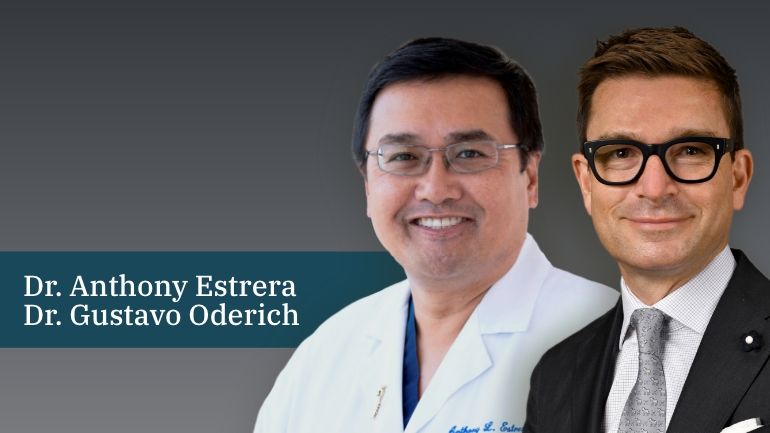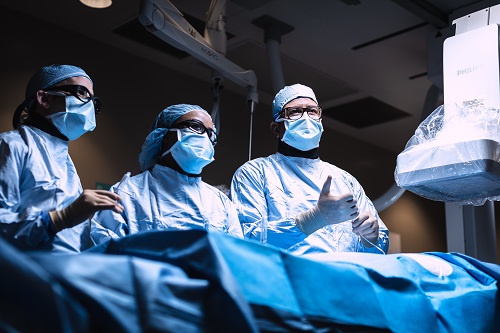The Next Frontier - Advancements in Aortic Surgery
Dr. Oderich and Dr. Estrera discuss what is an aortic surgery and when is it needed. The reasons why people get aortic disease and when do they start to experience them. Advances in aortic surgery, the three types of surgeries and some of the benefits of each.

The Next Frontier - Advancements in Aortic Surgery
Prakash Chandran (Host): Advancing health, personalizing care. At Memorial Hermann, this is our mission. This podcast shares the science and stories behind those efforts. Today, we'll be discussing advancements in aortic surgery. And joining us today are two guests affiliated with Memorial Hermann Health System: My first guest is Dr. Gustavo Oderich, Professor of Surgery and Chief of Vascular and Endovascular Surgery, Director of the Aortic Center and Director of the Advanced Endovascular Aortic Program at McGovern Medical School at UTHealth Houston. Joining us also is Dr. Anthony Estrera, Professor and the Hazim J. Safi, MD, Distinguished Chair in Cardiothoracic and Vascular Surgery at McGovern Medical School at UTHealth Houston and Medical Director of the Memorial Hermann Heart and Vascular Service Line.
This is Advance, the podcast series from Memorial Hermann. I'm Prakash Chandran. So, Dr. Oderich and Dr. Estrera, thank you so much for being here today. Dr. Oderich, I'd love to start with you. Let's start with just a basic, high-level question, what exactly is aortic surgery and when is it needed?
Dr. Oderich: Prakash, thank you for having me and Tony here with you today. What is aortic surgery? Well, aortic surgeries are those operations, those surgeries that are done to treat the diseases of the aorta. And that includes most often aneurysms, which we'll be talking about—dissections—but also trauma and some rare diseases as well.
Dr. Estrera: And I would like to add, the largest blood vessel of the body coming out of the heart. And as a blood vessel or what I would call a pipe that comes out of the heart, it carries blood to all the organs. So, as you can imagine, it's a very important structure within our bodies, carrying blood to, again, every organ.
Now, diseases of the aorta, as Gustavo mentioned, can occur, which includes aneurysms, which is an enlargement or ballooning out of that pipe, which then can eventually rupture and cause a lot of problems with patients who have aneurysms. So, I want to sort of add that to this discussion.
Dr. Oderich: So, Prakash, when we talk, you know, surgeries of the aorta, you know, there are basically three types of surgeries. We have the open surgical techniques, which are the conventional approach that has been done for decades. And in fact, the birthplace of those operations for the most part was here in Houston. We have the endovascular techniques, which involve use of stents that are placed using catheters and X-ray through small puncture holes and what we call hybrid operations, which combines the open surgery with stents. And which type of surgery we do depends on many factors, but also the location where we are treating.
You know, the aorta, as Dr. Estrera pointed out, is the largest blood vessel, so it extends from the heart, up and above or across the collar bone and then down through the chest and the belly all the way to below the belly button. Depending on which area of the aorta we are treating, you know, then one alternative becomes more important than the other and so forth.
Host: So, Dr. Estrera, one of the things that was mentioned was obviously aortic surgery treats aortic diseases, but why do people get aortic diseases in the first place? And when do they start to experience them, like at what age?
Dr. Estrera: Thank you, Prakash, for that question. Aortic diseases can really span all ages. Although, admittedly, most of the aortic problems we encounter are going to be in adulthood. Now, how does it occur? Remember the aorta is a structure, as I mentioned earlier, a pipe that has multiple layers within this wall of this pipe. It's that middle layer that gets weak and sort of the byproducts, the biomaterials that make up the wall, get weak. And as they get weak, like a balloon, it starts to expand. And if it gets too big, like a balloon, it can rupture.
Now, I'll say that this more frequently occurs in an older population, but there are some conditions in which it is inherited. In other words, there is a family history of aneurysms and problems with the aorta that occur at even a younger age. And so, although we don't see it very frequently in pediatric populations, meaning children, we do see it in younger adults all the way up to old, elderly patients in their 70s and 80s, and even 90s.
Host: And Dr. Oderich, I was wondering if you could talk a little bit about how an aortic disease initially gets diagnosed, like does a patient experience certain types of symptoms? Does it get picked up when they, you know, go in for their annual? Maybe talk a little bit about that.
Dr. Oderich: Good, Prakash. Well, I would separate a little bit, Prakash, aneurysms and dissections. You know, we're talking first about aneurysms. And the vast majority of aneurysms, they don't cause any symptoms. So, a lot of the patients are diagnosed incidentally. Now, we do recommend as part of screening that, you know, men or women that have a family history of aneurysms or those that smoke undergo an ultrasound of the aorta in the abdomen to see if there is any early sign of an aneurysm or already an aneurysm.
Now, the ultrasound is not able to image the chest. If a patient has a strong family history of aneurysms affecting the chest or one of the genetic diseases that Dr. Estrera has mentioned, we have to evaluate the entire aorta and that's done with a CT angiography or a CAT scan, which most often is a test we recommend for almost all the patients, at least on the phase that we are contemplating treatment. We pretty much always obtain a CT angiography. There are exceptions, patients can have allergy to the dye or have elevated kidney function tests, so that is not safe to do a CT with contrast. Magnetic resonance angiography, MRA, is an alternative that we can use as well.
Dr. Estrera: And if I could add, patients with aortic disease and you asked about screening, the symptoms that can occur in some patients with aortic diseases can mimic other conditions. A common one is a heart attack, which we think about the actual heart having a blockage of one of the vessels that provides blood to the heart. A heart attack or an aortic attack in which the aorta is rupturing or splitting like a dissection can [00:07:00] also present like a heart attack and can be confusing.
Host: So, it's interesting to get some clarity. You know, doctor, I wanted to ask you about, you know, we're talking about some of the advancements in aortic surgery. Dr. Oderich mentioned the three types of surgery, conventional, endovascular and a hybrid, which is a combination of the two. Is there anything our audience should know about some of the advances in aortic surgery as it relates to those three types of surgeries and some of the benefits that these advancements can bring?
Dr. Estrera: Prakash, that's a very good question and very relevant in this current day. As Dr. Oderich had mentioned before, the three varying types of surgery for the aorta, the classic, typical had always been the open repair where we actually make an incision in the chest or abdomen and directly replace that segment of aorta with an artificial material in the shape of a tube called Dacron. That was first invented by Dr. DeBakey, here in Houston in the 1950s. But that had been really the standard for a number of years as the way to repair these until endovascular treatments really came to the forefront in the mid-2000s.
And since that time, endovascular treatments have really gained a lot of popularity because of its minimally invasive approach. As Dr. Oderich mentioned earlier, instead of opening the chest or abdomen, you can actually exclude and treat an aneurysm with a simple puncture site, much less invasive than the open repair. And thus, it can be very complicated though, because the aorta has multiple branches. So, you have to have expertise in these approaches to treat these patients and especially complex patients with extensive aneurysms.
What I would say in general, it's important for patients to seek medical attention for aneurysms if they're diagnosed with one from a group that provides really a comprehensive approach to treating aneurysms and in essence have all the tools in the toolbox to treat the patient as opposed to just having one single approach in my opinion.
Dr. Oderich: I think Tony is hitting a very important point. When we look at how to manage these aortic diseases, there are what we call Comprehensive Aortic Centers. And those centers are able to offer all the alternatives that complement themselves and they're not necessarily competing between themselves. And it includes the medical part, which is the ability to have the cardiology team and the medical geneticists for those rare diseases to be able to do the preoperative assessment of these patients, to see that they are considered low or high risk for a type of surgery, then the ability to have the necessary imaging that is done in a proper way, so we can plan these operations, and the ability to offer the alternatives of the open surgery or the advanced endovascular surgery with equal expertise and without compromise.
Host: Now, Dr. Estrera, the word endovascular has been used a couple of times. And, you know, my lay understanding is that means that a long tube called the catheter is put into an incision in the groin and then used to basically go up into the aorta, so you're not making a massive cut or opening up the chest. It's called minimally invasive because it's going in through that tube. Do I have that understanding correct?
Dr. Estrera: Yeah, that's exactly right. The concept is not even an incision in the groin, but really just a small puncture site, entering the artery from usually the groin, but it can be the arm sometimes. And the actual graft or what we call stent graft, if you could imagine, you know, a device that is covered around a metal frame stent that is now crimped or reduced in size to the shape of a very small cylinder. And then that device is introduced into the puncture site, into the artery in the groin and cut through that artery into the location where you needed to be, and then it's released from the inside. So instead of replacing the entire aorta or that segment of diseased aorta, you are placing this sleeve, we call it that, within the vessel to seal it off and create this new pathway for blood to flow, that is exclusive of the previous aneurysm, now protecting the patient from an aneurysm rupture.
Host: And, you know, Dr. Oderich, you had mentioned kind of aneurysms versus dissections, and I'm assuming, dissections are considered more of a medical emergency when there's a tear and something needs to be done almost immediately. Now, is this endovascular treatment done in the case of a dissection or do you treat that medical emergency in a different way?
Dr. Oderich: So, dissection implies that the layers of the aorta are split, that we have the aortic wall, which is the wall of this pipe, has three layers that are packed like onion skin. And if the layers are split, we now have a situation where blood is flowing through the main central lumen of the pipe, but also through a new channel called the false lumen. It depends on the exact location, also on the timing. Is this acute, or is this a dissection that is already chronic, you know, because sometimes the patients have sustained a dissection years or months, years ago and down they present with now a dissection and an aneurysm, which is a chronic manifestation of the dissection.
But for example, if it's an acute dissection and is on the beginning part of the aorta called the ascending aorta, this is an area, that for the most part, currently is treated usually with open surgery as the first line of treatment, and this is the area of expertise of Dr. Estrera. On the other hand, if the dissection is in the lower part of the aorta, the descending aorta or in the abdomen, a lot of those we can treat medically controlling the blood pressure and the heart rate, and we can cool down that process. And if treatment is needed, for the most part, that's done currently with stents. So, it depends again on the timing. It depends on the location and also the presentation, of course, of the dissection.
Host: And, you know, just as we start to close here, Dr. Estrera, one of the things that we'd like to talk about is, you know, prevention or maybe said a different way, just ways to actually care for one's aortic valve. So, I imagine, like with most things, eating a heart-healthy diet, exercise, not smoking are ways that we can do that, but are there any other ways that we can take care of our aortic valve?
Dr. Estrera: Yeah. So other ways we can take care of our aortic valve and aorta and, in general, our cardiovascular status is what you mentioned, especially avoiding smoking and having a good heart-healthy diet, but also exercise. You know, I think getting on an exercise program has a number of benefits, not just from, you know, the general health benefits, but also from a cardiovascular standpoint in that it promotes lowering your blood pressure as well. Because when we know that we have an aneurysm, one of the most important things that I counsel patients is to make sure your blood pressure is under good control.
And what do I mean by that? The normal blood pressure is 120/80. So, 120 millimeters of mercury over 80 millimeters from mercury is "the normal blood pressure." But we all know that some patients will have blood pressures that extend into the top number of 140 to even 160 millimeters of mercury, which is too high. Because it makes sense, the higher your blood pressure, the greater pressure on the wall of that aorta and the greater risk for rupture or dissection. So, I think that becomes another important factor in the overall general health of patients with cardiovascular disease.
Host: And Dr. Oderich, any closing words from you just about what we've talked about here with regards to the advancements in aortic surgery or just keeping a healthy aorta?
Dr. Oderich: I think that Tony has summarized the strong points. I would say one of the neat things about working at Memorial Hermann and UTHealth Houston has been the ability to build this wonderful Comprehensive Aortic Center where the alternatives of the open surgery as well as advanced endovascular surgery go hand in hand. We often exchange ideas, myself and Dr. Estrera, about patients we have in common and really try to select what is best for the patient, depending on the anatomy of the aneurysm or the dissection, the presentation.
Host: All right. Well, Dr. Oderich and Dr. Estrera, thank you so much for this informative conversation, and I truly appreciate your time.
Dr. Estrera: Thank you, Prakash.
Host: For more information, you can head to memorialhermann.org/heart. That is Memorial Hermann with two N's dot org, slash heart. If you found this podcast helpful, please share it on your social channels and be sure to check out the entire podcast library for topics of interest to you. Thanks for checking out this episode of Advance.
My name is Prakash Chandran, and we'll talk next time.


